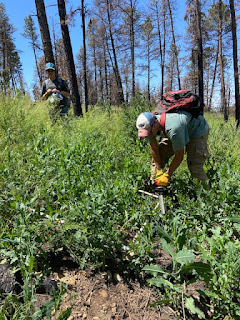Forage and Soils
Post by 2022 student Ethan Van-Derpoel
This section we looked at soils. Though not as colorful or charismatic as some of the flowers or wildlife, soil is the base for all living things. It is the ultimate force that decides what occupies the land. In a place as arid, windswept, and fire prone as the Montana prairie the soil is probably the most important factor, in my opinion, of this project.
Due to unforeseen circumstances and a little schedule change we also collected the forage samples for our plots while simultaneously conducting soil samples. We were able to meet some incredibly knowledgeable people regarding weeds, and forage. The first person we met was Meriel, the Musselshell County Weed Coordinator. She explained to us how some weeds got here, how they act in this environment, and how they treat for them. She also told us what it is like working with the public in her profession. Although working with the public was not the main reason that she was there talking to us it was a very important thing to note. She mentioned that she mostly dealt with considerate people who were very understanding and proactive in weed management, but there were a few who did not appreciate or understand what she did and were extremely confrontational. I feel that at Clemson we have learned more about human-wildlife conflicts and less about the human-human conflicts that happen when working in a natural resources profession. If people can not see eye to eye or at least learn to tolerate each other then the environment and wildlife will suffer. If a rancher is doesn’t allow treatment of weeds than those weeds will begin to spread and start affecting other properties, destroying not only the ecosystems but also the livelihoods of those who depend on the land.
Although we are not the typical wide-open rangeland here in the Bull Mountains, many rangeland management practices still apply. To learn more about rangeland practices, plants and general Montana ranching questions we met with Landon, a Rangeland Manager from the USDA-NRCS. He showed us the 17-point checklist for the rangeland health assessment and went over how each point is affected by either fire or invasive species or possibly even both. After a fire as intense as the Bobcat fire there is a huge problem of erosion since the plants are no longer able to stabilize the soil. That problem is exacerbated with invasives that might not be as fire adapted as native prairie species. Like many parts of Montana and throughout the country there are invasives across the ranch. However, they have been kept in check by the ranch owners following the best management practices. Landon was amazed at how well certain forage species were doing post fire on the ranch. I asked him about how the data we were gathering would tie into something like rangeland management and from what he explained the work we are doing is going to provide very important data that might show how projects like this are capable of proving the efficacy of good rangeland practices.
The second day of soil and forage sampling we had two people from Montana State University Central Ag Research Station and one from Little Bighorn College come and visit us while we were conducting soil and forage samples. As we were drilling for the soils Jeb from Montana State and his Graduate Assistant Jenny, who are conducting a somewhat similar study on fire and rangeland, were explaining the importance of soil communities in relation to ranching. To demonstrate he took a little core sample, firstly to show us how to take a core sample while also showing us how the soil looked in this area. He took the core sample in an area that had been thinned and burned. It was only a 10cm sample, but I was amazed at the depth of the organic matter and how far some roots of the grasses went. Since we have a site that has been burnt down to the rocks, it was especially amazing to see that the “extreme thinning”, as Goz called it, did so much to preserve the soil.
Just like the connections between the soil, plants, animals, and ranchers this section showed how connected different agencies and organization are and can be even with different goals. It was wonderful meeting with Montana State University since they are another land grant university with a mission similar to Clemson’s. But we also learned so much from the county weed coordinator, and with the amount of vegetation sampling we have done, and the iNaturalist observations we have made, we have found several noxious weeds on the ranch that might inform the weed coordinator and ranch owners of what is out here. It is like all the stakeholders out here are part of a community that, much like the soil community, must find a harmony that will allow all parts to thrive. I’m very glad that Clemson is going to be part of that harmony and that I was lucky enough to be here as well.



